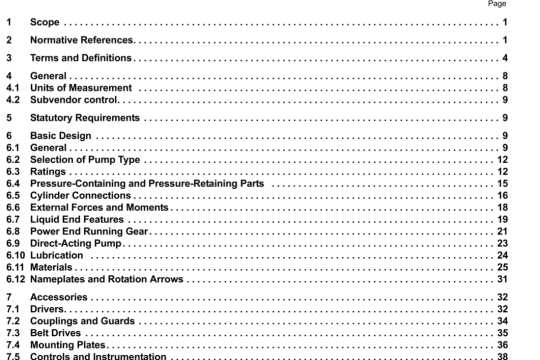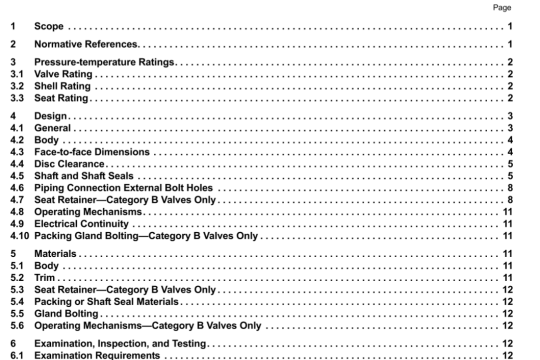API RP 2023:2001 pdf download
API RP 2023:2001 pdf download.Guide for Safe Storage and Handling of Heated Petroleum-Derived Asphalt Products and Crude-Oil Residua.
Before there is the possibility of a storage tank fire there must be a flammable mixture in the tank. Some actions to help prevent fires and explosions by controlling the vapor space in heated storage tanks are:
a. Ventilating to remove vapors and keep vapor space in the lean” range (for tanks with low ,latility materials stored at least 50°F below their open cup flash point).
b. Venting limited to a single vent that is properly sized [see
API 20001.
c. Preventing restriction caused by condensed, solidified deposits building up in the vent.
d. Keeping gauge hatches closed during normal operation.
e. Regulating the storage temperature to keep the evolved vapors outside the flammable range (either too lean or too rich—see Appendix Di).
f. Careful control if lines are blown with air (see 6.4).
g. Careful control if using air fur mixing (see 7.3).
h. Inert blanketing the vapor space to reduce oxygen content.
i. Temporanly inerting the vapor space with flue gas or another suitable medium when tanks are emptied at rates Substantially above normal.
Ignition of hydrocarbon vapors is possible when the oxygen level is about 11% (by volume) or greater. To maintain a safety margin, SOLAS calls for a maximum of 8% (by volume) oxygen in inert blanketed tanks on board crude oil tankers. This is achieved using systems supplying inert gas with a maximum of 5% oxygen. Inert gas is lighter (lower molecular weight) than hydrocarbon/air mixtures. If blanketing is used, the potential “time effect” of the inerting technique should be recognized. If the inert gas is introduced near the top there can be stratification in the tank, with the heavier air/fuel mixture near the surface of the stored hydrocarbon. Diffusion and thermal currents will eventually provide dilution of the original atmosphere. If an empty tank is being inert blanketed this stratification effect can be used to advantage by venting the tank of HC vapors from the bottom with inert gas introduced near the top. This will tend to displace (instead of dilute) the heavier hydrocarbon/air mixture. Potential personnel exposure and environmental issues should be addressed. Tanks which have been inert blanketed may require special procedures when being removed from service (see 63.2) because inerting can cause a buildup of pyrophonc iron sulfide.
Precautions against exposure to sources of ignition should be emphasized and observed. If ignition occurs inside a tank there may be an internal explosion. The resulting overpressure may cause the tank’s roof to and separate from the shell. The result will be a full surface (or partiaily impeded) tank fire. Suppression is discussed bnefly in 4.7 and Appendix K, and in more depth in API RP 2021. See Appendix A for some handling suggestions.
4.6.1 POTENTIAL FUEL SOURCES
Hydrocarbons must be in the vapor phase to burn and be in their flammable range. Temperature control and knowledge of material in tanks become very significant. This is especially true if a tank is being switched from one service w another, particularly where hot heavy product is being mixed with cool product containing a light fraction (e.g. cutbacks). As the temperature in the tank goes higher there will be mote vapor generated. If the temperature goes vety high (over approximately 450°F). or there is localized overheating, then light vapors may be generated as a result of cracking. In these cases, the light components released can increase the fire hazard.
Some situations in which ranks may have a flammable mixture include:
a. Nearly empty tanks containing a product with an appreciable por pressure at the tank temperature. (Air will be drai into vented atmosphenc tanks as product is withdrawn).
b. Tanks being filled from a relatively low level (with air in the headspace) with a product which has an appreciable vapor pressure at the rundown temperature.
c. Tanks at a temperature higher than norma] for low vapor pressure products.
d. Tanks ith a non-functioning inert gas blanket.
e. While air-blowing asphalts.
f. Mixing or contamination with a small amounts of light solvent
g. Material heated above the flash point.
h. Inadequate ventilation (normal vents do not draw off vapors).




